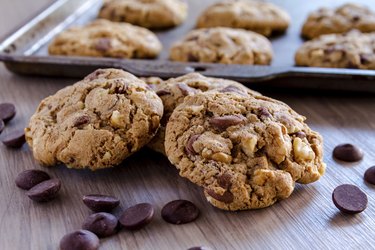
Cream of tartar helps cookies rise, keeps them from overbrowning, and can affect both taste and texture. Depending on the specific cookie recipe you use, cream of tartar works alone or appears as an ingredient in baking powder. Made from the acidic residue left in wine barrels after grapes finish fermenting, cream of tartar is either an essential and invaluable addition to cookies, or, for some cookies, an ingredient to avoid.
Providing Leavening
Video of the Day
Cream of tartar in baking powder helps cookies rise. The acid in cream of tartar reacts with the liquids in cookie dough to produce carbon-dioxide gas bubbles, which break apart the gluten in the flour and lift the cookie dough. Baking powder labeled double-acting also contains sodium aluminum sulfate in addition to the cream of tarter. In some recipes, cream of tartar alone provides the acidity that enables baking soda to also work as a leavening agent.
Video of the Day
Controlling Texture
Because cream of tartar makes cookies rise, it also gives them a lighter and typically more chewy texture than cookies made without a leavener, such as wafer cookies and sandwich cookies, which typically skip leavening of any kind. In addition to creating air bubbles when it comes into contact with liquid, cream of tartar also has a second reaction when it's heated. At this point, the initial bubbles become larger, creating an even lighter and more tender texture in the cookies.
Affecting Sugar Chrystals
With its high acidic makeup, cream of tartar keeps sugar molecules from forming into crystals, with three consequences:
Fewer sugar crystals means cookies turn slightly less brown.
The icing for frosted cookies and the cream filling for sandwich cookies is more creamy and less gritty when you add a pinch of cream of tartar.
Meringue cookies taste smoother and less gritty when you use a pinch of cream of tarter, which inhibits sugar crystal formation.
Adding Flavor
Cream of tartar sometimes adds a flavorful tanginess and can neutralize the overly bitter taste of too much baking soda. The editors of Baking Illustrated use 2 teaspoons of cream of tartar in a snickerdoodles cookie recipe to add what they call a "subtle tang or sour undercoating." If one of your cookie recipes always comes out tasting bitter from too much baking soda, try adding 1/4 to 1/2 teaspoon of cream of tartar the next time you make the cookies.